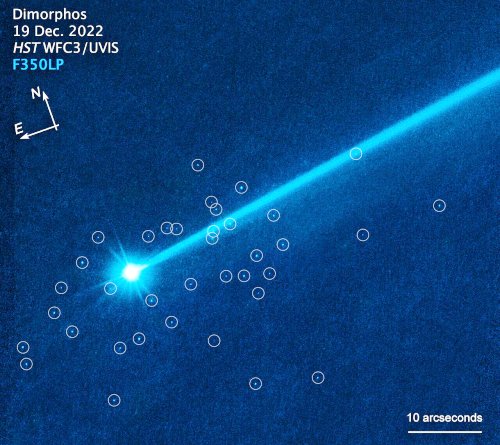Hubble image shows several dozen boulders flung from Dimorphos
Using the Hubble Space Telescope, astronomers have photographed several dozen boulders that were flung off of the asteroid Dimorphos following the impact by the space probe DART. The picture to the right, reduced and brightened to more clearly show those boulders, was taken on December 19, 2022, four months after DART’s impact.
These are among the faintest objects Hubble has ever photographed inside the Solar System. The ejected boulders range in size from 1 meter to 6.7 meters across, based on Hubble photometry. They are drifting away from the asteroid at around a kilometre per hour.
The blue streak is the dust tail that has streamed off of Dimorphos since the impact, pushed away from the sun by the solar wind.
On Christmas Eve 1968 three Americans became the first humans to visit another world. What they did to celebrate was unexpected and profound, and will be remembered throughout all human history. Genesis: the Story of Apollo 8, Robert Zimmerman's classic history of humanity's first journey to another world, tells that story, and it is now available as both an ebook and an audiobook, both with a foreword by Valerie Anders and a new introduction by Robert Zimmerman.
The print edition can be purchased at Amazon or from any other book seller. If you want an autographed copy the price is $60 for the hardback and $45 for the paperback, plus $8 shipping for each. Go here for purchasing details. The ebook is available everywhere for $5.99 (before discount) at amazon, or direct from my ebook publisher, ebookit. If you buy it from ebookit you don't support the big tech companies and the author gets a bigger cut much sooner.
The audiobook is also available at all these vendors, and is also free with a 30-day trial membership to Audible.
"Not simply about one mission, [Genesis] is also the history of America's quest for the moon... Zimmerman has done a masterful job of tying disparate events together into a solid account of one of America's greatest human triumphs."--San Antonio Express-News
Using the Hubble Space Telescope, astronomers have photographed several dozen boulders that were flung off of the asteroid Dimorphos following the impact by the space probe DART. The picture to the right, reduced and brightened to more clearly show those boulders, was taken on December 19, 2022, four months after DART’s impact.
These are among the faintest objects Hubble has ever photographed inside the Solar System. The ejected boulders range in size from 1 meter to 6.7 meters across, based on Hubble photometry. They are drifting away from the asteroid at around a kilometre per hour.
The blue streak is the dust tail that has streamed off of Dimorphos since the impact, pushed away from the sun by the solar wind.
On Christmas Eve 1968 three Americans became the first humans to visit another world. What they did to celebrate was unexpected and profound, and will be remembered throughout all human history. Genesis: the Story of Apollo 8, Robert Zimmerman's classic history of humanity's first journey to another world, tells that story, and it is now available as both an ebook and an audiobook, both with a foreword by Valerie Anders and a new introduction by Robert Zimmerman.
The print edition can be purchased at Amazon or from any other book seller. If you want an autographed copy the price is $60 for the hardback and $45 for the paperback, plus $8 shipping for each. Go here for purchasing details. The ebook is available everywhere for $5.99 (before discount) at amazon, or direct from my ebook publisher, ebookit. If you buy it from ebookit you don't support the big tech companies and the author gets a bigger cut much sooner.
The audiobook is also available at all these vendors, and is also free with a 30-day trial membership to Audible.
"Not simply about one mission, [Genesis] is also the history of America's quest for the moon... Zimmerman has done a masterful job of tying disparate events together into a solid account of one of America's greatest human triumphs."--San Antonio Express-News



That is the exact scenario that points to REFUSING TO TRY TO DEFLECT asteroids with any kind of bomb.
Now there is this shot gun blast of large bolides careening through space. Where is it going? I have been looking but I can’t find anything in Lay man’s language that says whether or not this thing crosses Earth Orbit. Even thought some call it a Near Earth Object.
ACK
Andrew Winter: Dimorphus and its parent asteroid Didymos are in a near Earth orbit, but that orbit is no threat to Earth, at all. Before DART was launched scientists choose this asteroid because of this definite fact.
Moreover, the boulders are tiny. Almost all would burn up in the atmosphere if they did happen to cross the Earth’s path.
Having said that, you point is still correct. Blowing up a rubble-pile asteroid is a fool’s errand, and would likely cause more problems. It not only would not destroy the asteroid, it would add more objects that would hit the ground over a wider area.
DART however was not testing how to blow up an asteroid, but how an impact might adjust its orbit. If you could change the orbit enough you could prevent a threatened Earth impact entirely. DART showed it could change Dimorphus’ solar orbit, but we still don’t know how much exactly. We need time to track it to measure the full change.